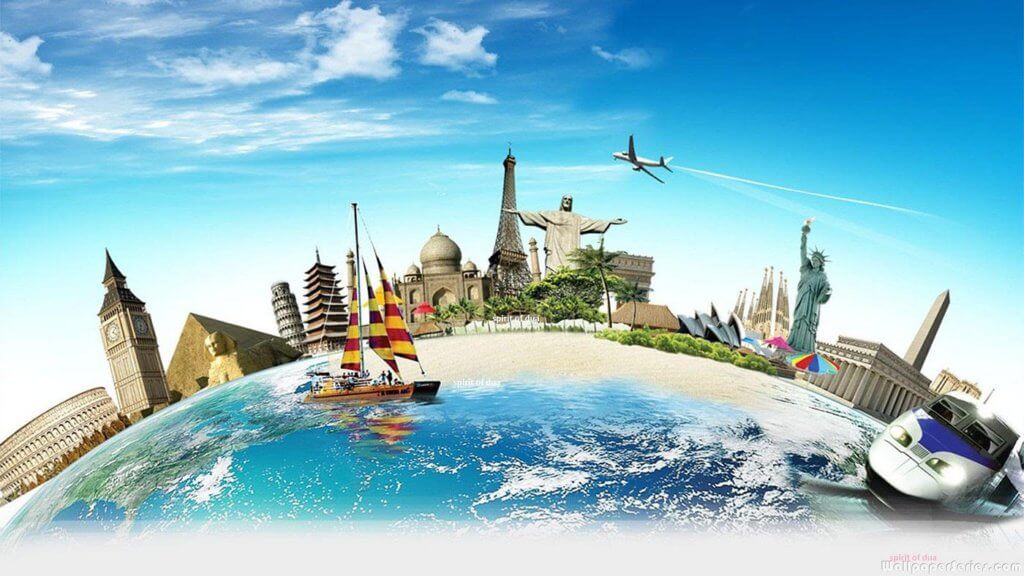Business Travel Guide
12 Different Types of Tourism You Need to Know

Tourism is a vast and diverse industry that has been growing steadily over the years. It is a significant contributor to the global economy, and its impact is felt across various sectors. Tourism can be defined as the act of travelling for entertainment, pleasure or business purposes. It involves visiting places of interest, exploring new cultures, and experiencing different types of tourism, and each has its unique characteristics and attractions.
Cultural tourism is one of the most common types of tourism, and it involves visiting places of historical and cultural significance. Eco-tourism is a type of tourism that focuses on the conservation of natural resources and the promotion of sustainable tourism. Health tourism is another type of tourism that involves travelling to destinations for medical treatment or wellness purposes.
Key Takeaways
- Tourism is a diverse industry that involves travelling for pleasure or business purposes.
- There are various types of tourism, including cultural tourism, adventure tourism, eco-tourism, and health tourism.
- Each type of tourism has its unique characteristics and attractions, and they contribute to the growth of the global tourism industry.
1. Cultural Tourism
Cultural tourism is one of different types of tourism that involves travelling to experience the culture and heritage of a destination. It is a way to explore the customs, traditions, history, and art of a place. Cultural tourism is a popular form of tourism that attracts millions of visitors each year.
- Historical visits
Historical visits are a popular form of cultural tourism. Many people travel to historical sites to learn about the past and experience the culture of a destination. Historical sites can include ancient ruins, castles, and museums. These sites offer a glimpse into the history and culture of a place and can be a great way to learn about the past.
- Culinary exploration
Culinary exploration is another popular form of cultural tourism. Many people travel to experience the food and drink of a destination. This can include trying local cuisine, visiting food markets, and taking cooking classes. Culinary tourism is a great way to experience the culture of a place through its food and drink.
- Art and literature tours
Art and literature tours are a great way to experience the culture of a destination. Many people travel to explore the art and literature of a place. This can include visiting museums, galleries, and historic sites related to art and literature. Art and literature tours can provide a deeper understanding of the culture and heritage of a place.
2. Business Tourism
Business tourism, also known as corporate travel, refers to travel that is done for work-related purposes. It is a subset of regular tourism and involves individuals who are still working and being paid while away from both their workplace and home.
We have different types of business travel and accommodation. Business tourism can take many forms, including attending conferences, meetings, trade shows, and exhibitions.
According to Yahoo, corporate travel is expected to reach a global market value of $1.5 trillion by 2028, which is nearly three times itis 2020 levels. This is not surprising, given the extraordinary ROI of business travel. For every $1 a company spends on travel arrangements, they get back $12.5 in revenue.
Business tourism can be divided into four main categories, which are:
- Meetings: A meeting is an event where people come together to discuss a specific topic or issue. Meetings can be held for various purposes, such as to share information, make decisions, or solve problems. They can be held in a variety of venues, such as hotels, conference centres, or offices.
- Incentives: An incentive in corporate travel is a reward given to employees or customers for achieving a specific goal or target. Incentive travel is a form of business tourism that involves rewarding employees or customers with a trip or holiday.
- Conventions: A convention is a large meeting or conference that is usually held over several days. Conventions are often held by professional associations or trade organisations and can attract thousands of attendees.
- Exhibitions: An exhibition is an event where companies or organisations showcase their products or services. Exhibitions can be industry-specific or open to the general public.
Business tourism is an important part of international tourism, and it is expected to continue to grow in the future. It provides opportunities for individuals and companies to network, learn, and do business with others from around the world.
3. Adventure Tourism
Adventure tourism is a type of tourism that involves travelling to remote and exotic locations outside of one’s comfort zone. It is characterised by activities that are physically and mentally challenging, and often involve an element of risk. There are many different types of adventure tourism, each with its own unique experiences and challenges.
- Mountain climbing
Mountain climbing is a popular form of adventure tourism that involves climbing to the summit of a mountain. This activity requires a high level of fitness, as well as technical skills and equipment. Some of the most popular mountain climbing destinations include Mount Everest in Nepal, Kilimanjaro in Tanzania, and the Matterhorn in Switzerland.
- Scuba diving
Scuba diving is another popular form of adventure tourism that involves exploring the underwater world. This activity requires specialised equipment and training and can be done in a variety of locations, including coral reefs, shipwrecks, and underwater caves. Some of the most popular scuba diving destinations include the Great Barrier Reef in Australia, the Red Sea in Egypt, and the Galapagos Islands in Ecuador.
- Safari expeditions
Safari expeditions are a type of adventure tourism that involves exploring wildlife reserves and national parks in search of exotic animals. This activity can be done on foot, by vehicle, or even by hot air balloon. Some of the most popular safari destinations include the Serengeti in Tanzania, Kruger National Park in South Africa, and the Masai Mara in Kenya.
Adventure tourism is a great way to explore the world and push oneself to new limits. However, it is important to remember that these activities can be dangerous and should only be undertaken with proper training and equipment.
4. Eco-Tourism
Eco-tourism is a type of tourism that focuses on responsible travel to natural areas while conserving the environment and improving the well-being of local people. It involves activities that are designed to minimize the negative impact on the environment and promote conservation efforts.
- Wildlife sanctuaries
Wildlife sanctuaries are an important part of eco-tourism. They provide a safe haven for endangered species and help to preserve their natural habitat. Visitors can observe wildlife in their natural environment while learning about conservation efforts. Wildlife sanctuaries also offer opportunities for research and education.
- Conservation projects
Conservation projects are another important aspect of eco-tourism. These projects are designed to protect the environment and promote sustainable development. Visitors can participate in activities such as tree planting, beach clean-ups, and wildlife monitoring. These projects not only help to protect the environment but also provide economic benefits to local communities.
- Eco villages
Eco-villages are communities that are designed to be environmentally sustainable. They use renewable energy sources, organic farming, and other eco-friendly travel tips & practices. Visitors can learn about these practices while experiencing the local culture and way of life. Eco-villages also provide opportunities for visitors to participate in community projects and learn about sustainable living.
Overall, eco-tourism is a great way to promote conservation efforts while providing economic benefits to local communities. By choosing eco-tourism, visitors can have a positive impact on the environment and support sustainable development.
5. Health Tourism
Health tourism is a growing industry that involves travelling to another country to receive medical treatment or improve one’s health and well-being. This type of tourism is divided into two main categories: spa and wellness retreats and medical treatments abroad.
- Spa and wellness retreats
Spa and wellness retreats are a popular form of health tourism that involves staying at a resort or hotel that offers a range of wellness services, such as massages, yoga classes, and healthy meals. These retreats are designed to help individuals relax, rejuvenate, and improve their overall health and well-being.
Some of the most popular spa and wellness retreat destinations include Bali, Thailand, and India. These countries offer a range of wellness services at affordable prices, making them attractive destinations for those looking to improve their health and well-being.
- Medical treatments abroad
Medical treatments abroad are another form of health tourism that involves travelling to another country to receive medical treatment. This type of tourism is particularly popular among those who live in countries with limited medical resources or high healthcare costs.
Some of the most common medical treatments received abroad include dental work, cosmetic surgery, and fertility treatments. Countries such as Thailand, India, and Mexico are popular destinations for medical tourism due to their lower medical costs and high-quality medical facilities.
It is important to note that medical treatments abroad carry certain risks, such as language barriers, differences in medical practices, and lack of follow-up care. Therefore, it is important to thoroughly research the medical facility and treatment before making any travel arrangements.
6. Sports Tourism
Sports tourism is a type of tourism that involves travel to participate in or observe sporting events. It is a fast-growing sector of the global travel industry, with a wide range of activities and events available to tourists.
- international sporting events
One of the most popular forms of sports tourism is attending international sporting events. These events can include the Olympics, the World Cup, and other major tournaments. Tourists can travel to different countries to watch their favourite teams and athletes compete against each other. These events can also be a great way to experience the local culture and cuisine of the host country.
- Golf vacations
Golf vacations are another popular form of sports tourism. Golfers can travel to different destinations around the world to play on some of the best golf courses. These vacations can include all-inclusive packages that provide accommodation, meals, and access to the golf course. Some of the most popular golf destinations include Scotland, Ireland, and the United States.
- Skiing holidays
Skiing holidays are a popular winter sports tourism activity. Tourists can travel to different ski resorts around the world to ski or snowboard on the slopes. These resorts offer a range of activities, including skiing, snowboarding, and other winter sports. They also provide accommodation, meals, and other amenities to make the holiday more enjoyable.
7. Religious Tourism
Religious tourism is a type of tourism that involves travelling for religious purposes or to see things of religious importance. It is also known as faith tourism and incorporates a wide range of activities, including pilgrimages and spiritual retreats.
- Pilgrimages
Pilgrimages are a type of religious tourism that involves travelling to a holy site or shrine. They are often undertaken for spiritual or religious reasons and can be a powerful way for individuals to connect with their faith. Pilgrimages can be short or long and may involve walking, cycling, or travelling by other means of transportation. They can also be group or solo experiences.
- Spiritual retreats
Spiritual retreats are another type of religious tourism that involves spending time in a quiet, peaceful environment to reflect on one’s spiritual beliefs. These retreats can be led by a spiritual leader or taken individually. They can be a way for individuals to deepen their connection with their faith and find inner peace.
Religious tourism is a significant aspect of the tourism industry in many countries around the world. It can have a positive impact on local economies, providing jobs and income for local businesses. It can also have a positive impact on individuals, providing them with a way to connect with their faith and find inner peace.
8. Educational Tourism
Educational tourism is a type of tourism that involves travelling to a destination with the primary purpose of learning something new. It is an excellent way for individuals to gain knowledge and skills while experiencing new cultures and environments.
- Student exchange programs
Student exchange programs are a popular form of educational tourism. These programs allow students to study abroad for a semester or a year while attending a foreign university. Students can learn a new language, experience a new culture, and gain valuable academic experience. Some universities offer exchange programs with partner institutions, while others offer independent study options.
- Research trips
Research trips are another form of educational tourism. These trips are designed for individuals who want to conduct research in a particular field or area. They can be organised by academic institutions, research organisations, or individuals. Research trips can be a great way to gain first-hand experience, collect data, and develop new skills.
Overall, educational tourism is an excellent way for individuals to gain knowledge and skills while experiencing new cultures and environments. Whether it’s through student exchange programs or research trips, educational tourism can provide a valuable learning experience for individuals of all ages.
9. Cruise & Rail Tourism
Cruise tourism is a type of travel focused on leisure, offering an all-inclusive experience on luxurious cruise ships for at least 24 hours. Passengers enjoy a range of amenities and activities, such as swimming pools, casinos, and theaters, making cruising a popular choice for those seeking both relaxation and excitement.
While cruise tourism is most popular in the Caribbean, Mediterranean, and Arctic regions, luxury rail tours are an equally enticing alternative. Travelers can explore a range of luxury packages on the renowned Rovos Rail, traveling iconic routes to destinations like Victoria Falls, Cape Town, and Pretoria. For those interested, Rovos Rail price options offer an exquisite, high-end travel experience with stops at historic cities and breathtaking landscapes.
Both cruising and luxury train travel allow passengers to follow a set itinerary, immersing them in diverse cultures and multiple destinations, all within a single, unforgettable journey.
There are different types of cruise ships available for passengers to choose from, depending on their preferences and budget. Some of the major types of cruise ships include:
- Luxury cruise: These are high-end cruise ships that offer luxurious amenities and services to passengers.
- Expedition cruise: These are small ships that are designed for adventure and exploration. They are ideal for passengers who want to explore remote and exotic destinations.
- Mega cruise: These are large cruise ships that can accommodate thousands of passengers. They offer a wide range of amenities and services, including multiple restaurants, bars, and entertainment options.
- Themed cruise: These are cruise ships that are designed for specific interests, such as music, food, or sports.
- Adventure cruise: These are cruise ships that are designed for adventure activities, such as hiking, kayaking, and snorkelling.
- Single cruise: These are cruise ships that are designed for solo travellers. They offer a range of activities and social events to help solo travellers meet other passengers.
10. Dark Tourism
Dark tourism is a type of tourism that involves visiting places associated with death, tragedy, and suffering. It is also known as grief tourism, black tourism, or thanatourism. The term “dark tourism” was first coined by two researchers, John Lennon and Malcolm Foley, in 1996.
According to Tourism Teacher, there are seven main types of dark tourism sites. These include:
- Death and tragedy sites: These are places where death or tragedy has occurred, such as battlefields, disaster sites, and places of execution.
- Genocide and atrocities sites: This is any place where large-scale violence, such as genocide, has occurred, such as concentration camps, killing fields, and memorials.
- Cemeteries and mausoleums: This is where the dead are buried or interred, such as graveyards, tombs, and catacombs.
- Museums and exhibitions: These are places that exhibit objects or information related to death and tragedy, such as holocaust museums, crime museums, and medical museums.
- Dark fun factories: These are places that offer entertainment related to death and tragedy, such as escape rooms, zombie chases, and theatrical activities.
- Literary and film locations: These are places associated with famous works of literature or film that deal with death and tragedy, such as the locations used in the Harry Potter series or the film Schindler’s List.
- Dark natural sites: These are natural sites associated with death and tragedy, such as volcanoes, caves, and mountains where people have died.
11. Space Tourism
Space tourism is a relatively new type of tourism that involves commercial space travel for recreational purposes. It has become increasingly popular in recent years, with several companies offering different types of space tourism experiences.
Types of Space Tourism
There are three main types of space tourism: suborbital, orbital, and lunar.
Suborbital space tourism
Suborbital space tourism involves taking passengers to the edge of space, providing them with a view of Earth from above and a taste of weightlessness. In these missions, spacecraft reach altitudes between 80 to 100 kilometres before returning to Earth. Suborbital flights last a few minutes and are designed to give passengers a brief experience of space travel. Companies such as Virgin Galactic and Blue Origin are currently working on suborbital space tourism programs.
Orbital space tourism
Orbital space tourism involves taking passengers into Earth’s orbit, allowing them to experience several days or weeks in space. This type of space tourism is more expensive and requires more training than suborbital space tourism. In 2001, American businessman Dennis Tito became the first space tourist to visit the International Space Station (ISS). Since then, several other space tourists have visited the ISS, including Guy Laliberté, the founder of Cirque du Soleil.
Lunar space tourism
Lunar space tourism involves taking passengers to the Moon, allowing them to explore its surface and experience the Moon’s low-gravity environment. This type of space tourism is still in development, with only a few companies, such as SpaceX and Blue Origin, currently working on lunar space tourism programs.
Space tourism is still in its early stages, but it has the potential to become a significant industry in the future. As technology advances and becomes more affordable, more people may have the opportunity to experience space travel. However, safety concerns and high costs are still major obstacles that need to be addressed before space tourism can become a mainstream industry.
Frequently Asked Questions
What are the main categories of tourism?
The main categories of tourism are leisure tourism, business tourism, adventure tourism, cultural tourism, educational tourism, medical tourism, religious tourism, and eco-tourism. Each category is defined by the primary motivation of the traveller and the activities they undertake during their trip.
How do different types of tourism impact the economy?
Tourism has a significant impact on the economy of many countries. The tourism industry creates jobs, generates revenue, and contributes to the development of infrastructure. The economic impact of different types of tourism can vary depending on the destination and the activities undertaken by travellers.
What are the characteristics that define each tourism type?
Each type of tourism has unique characteristics that define it. For example, leisure tourism is characterised by relaxation and enjoyment, while adventure tourism is characterised by risk-taking and physical activity. Cultural tourism focuses on experiencing local traditions and customs, while eco-tourism emphasises sustainability and environmental conservation.
In what ways do tourism types vary internationally?
Tourism types can vary significantly between countries and regions. For example, religious tourism may be more prevalent in countries with a strong religious heritage, while eco-tourism may be more popular in countries with unique natural environments. The popularity of different types of tourism can also be influenced by factors such as climate, geography, and cultural traditions.
Can you list the primary sectors within the tourism industry?
The primary sectors within the tourism industry include accommodation, food and beverage, transportation, attractions and activities, and travel services. Each sector plays a vital role in supporting the tourism industry and contributing to the overall tourism experience.
How is tourism classified according to traveller motivation?
Tourism can be classified according to traveller motivation into three categories: domestic tourism, inbound tourism, and outbound tourism. Domestic tourism refers to travel within the traveller’s own country, while inbound tourism refers to travel by foreign visitors to the country. Outbound tourism refers to travel by residents of a country to other countries. Each category is characterised by different motivations and travel patterns.




